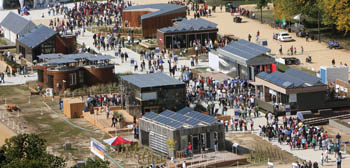
Image Credit: Stefano Paltera / U.S. Department of Energy Solar Decathlon
Image Credit: Stefano Paltera / U.S. Department of Energy Solar Decathlon Team California's solar-powered house, which won first place in the architecture contest.
Image Credit: Stefano Paltera / U.S. Department of Energy Solar Decathlon University of Louisiana at Lafayette student Tony Vaccarella awaits visitors in front of his team's house, which took first place in the market viability contest.
Image Credit: Stefano Paltera / U.S. Department of Energy Solar Decathlon The University of Wisconsin-Milwaukee's house illuminated by LED lighting during the lighting design contest.
Image Credit: Stefano Paltera / U.S. Department of Energy Solar Decathlon Visitors tour the University of Illinois at Urbana-Champaign's house.
Image Credit: Stefano Paltera / U.S. Department of Energy Solar Decathlon Another view of the Illinois Team's entry.
Image Credit: Richard King / U.S. Department of Energy Solar Decathlon Visitors at the house designed and built by Team Ontario/BC, which represents students and faculty from the University of Waterloo, Ryerson University, and Simon Fraser University.
Image Credit: Stefano Paltera / U.S. Department of Energy Solar Decathlon
One of the enduring lessons from the Solar Decathlon, whose fourth edition is now underway on the National Mall in Washington, D.C., is that it really does take a village to show off the range of technical achievement and imagination that the contest’s 20 competing academic teams have put on display. Staging the Decathlon – including the assembly of each team’s solar-powered house, judging of competition entries, public viewings, and the disassembly of each house – takes up most of October, although the actual contest runs from October 8 through 18. Each team puts in many months of planning just to apply for a spot in the competition, and then puts in another couple of years to prepare its project for presentation on the Mall.
The whole exercise is complex, exhausting, and rewarding in ways that most participants, or even the Department of Energy, which sponsors the biennial event, can’t quite fathom until the whole thing is over and everyone has had time to fully digest the results. But the event has become very high-profile, and seems to draw no shortage of visitors, who, as noted by the National Journal, even included folks from Capitol Hill, such as Representative Mike Arcuri, of upstate New York, and Senator Daniel Akaka, of Hawaii. The exhibition “has opened my mind to the practical uses of solar,” Akaka told the National Journal, noting that solar is an abundant resource in his state. Arcuri, meanwhile, said he is impressed by the level of achievement among the contestants, but added that “there are limitations to solar in upstate New York. You don’t get that kind of sun.” As of Thursday, standings in 8 of the 10 competition categories – architecture, market viability, lighting design, communications, comfort zone, hot water, appliances, and home entertainment – had been announced, with Team Illinois (representing the University of Illinois at Urbana Champaign) and Team California (Santa Clara University and the California College of the Arts) earning the most points overall. So far. Judging still needs to be completed in the engineering and net metering categories. (This is the first Decathlon in which the houses are hooked up to the grid rather than depending on batteries for power storage.) Hear from a few 2009 Solar Decathlon team members in this video:
Weekly Newsletter
Get building science and energy efficiency advice, plus special offers, in your inbox.














0 Comments
Log in or create an account to post a comment.
Sign up Log in